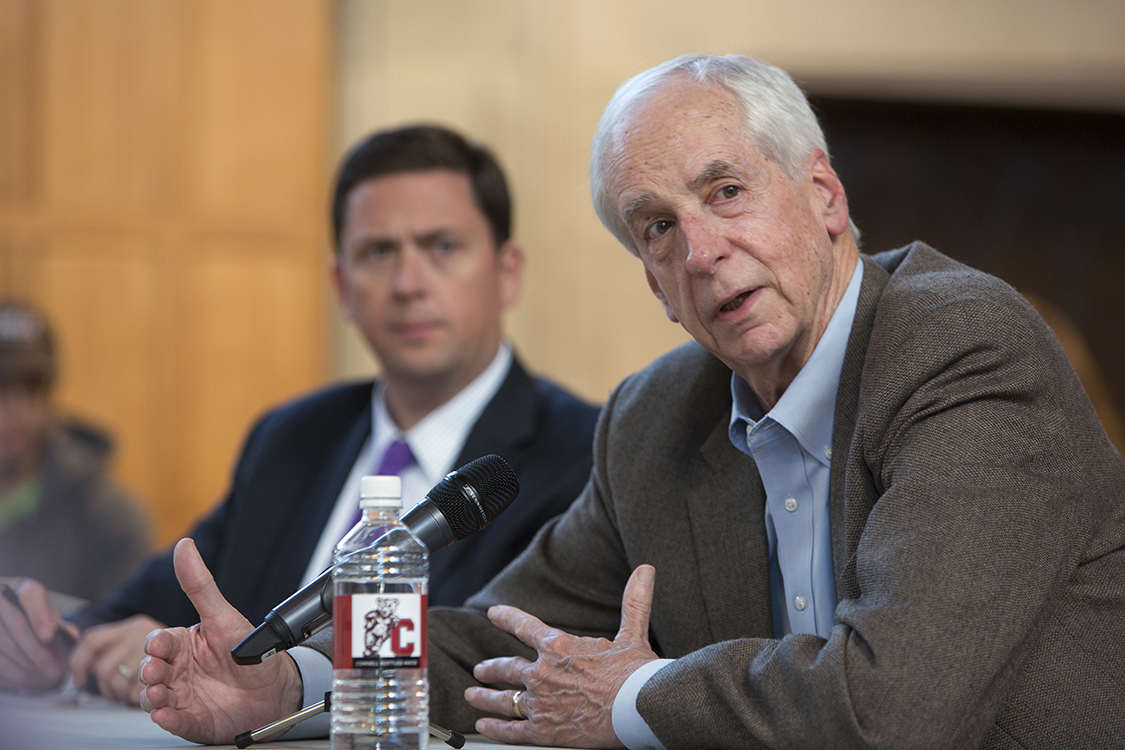Rawlings, Lombardi address public safety at Student Assembly
By Tom Fleischman

Interim President Hunter Rawlings and Vice President for Student and Campus Life Ryan Lombardi discussed campus safety and undergraduate curriculum at the Oct. 13 Student Assembly meeting.
Rawlings answered student questions regarding curriculum for much of their 30-minute appearance, but he and Lombardi also addressed issues of campus safety, in the wake of separate stabbing incidents on or near campus this semester. The first incident, on Aug. 28 near the corner of College Avenue and Campus Road, resulted in the death of Ithaca College sophomore Anthony Nazaire.
CornellALERT
Members of the Cornell community are encouraged to sign up on the Emergency website to receive CornellALERT messages.
In response to a question about students’ role in ensuring a safe campus, Rawlings said: “Students have a huge role to play – huge. … Students have to be smart about [safety] … especially at night, when most crimes are committed. Staying together might sound very simple, but when an individual is walking by himself or herself, they’re a much bigger target than if they’re in a group.”
Regarding the “shelter in place” text warning that went out following the September incident on Stewart Avenue, Lombardi first put in a plea for more students to sign up for the emergency text service. He also noted that he’d had conversations with several house deans on West Campus to discuss protocols and the steps they had taken to ensure safety as the incident played out. A suspect, who is not affiliated with the university, was identified and turned himself in Oct. 7; he is scheduled to face a preliminary hearing Oct. 19.
A student asked Rawlings about communication from the university to parents in the wake of the September incident, and if any changes in protocol could be expected.
“We try to communicate with parents as soon as we possibly can,” Rawlings said, noting that some can be reached by email, but “we unfortunately have many that we can’t reach right away.” Efforts are being made to increase the reach of the university’s email notification system, he added.
Rawlings said that since the August incident, Cornell University Police has increased the number and frequency of both patrols and Blue Light escorts. He added that the university will increase the number of video cameras installed across campus.
“It’s unfortunate that we have to do this,” he said, “but I think we need to add these elements in order to be safer.”
Another student wondered if anything could be done to shorten the time between an incident and email/text notifications. That alerts don’t go out immediately after an incident is for a reason, Rawlings said, noting that calling first responders, police tending to injured until an ambulance arrives, and securing the scene and assessing the situation all must occur before an accurate public safety alert can be sent out.
“These things don’t just occur instantaneously; each step has to be followed before the alert goes out,” he said.
Lombardi noted that, in the case of the September incident, it happened just off campus, so the transition of information from the Ithaca Police Department to the Cornell Police Department caused a slight delay, as well. Rawlings said that, while CUPD maintains strong relationships with its partner law enforcement agencies, the university is looking to streamline the process.
The August incident is still under investigation, and Rawlings put out another plea for anyone with any information or video evidence to contact the Ithaca Police Department at 607-272-3245.
Media Contact
Get Cornell news delivered right to your inbox.
Subscribe